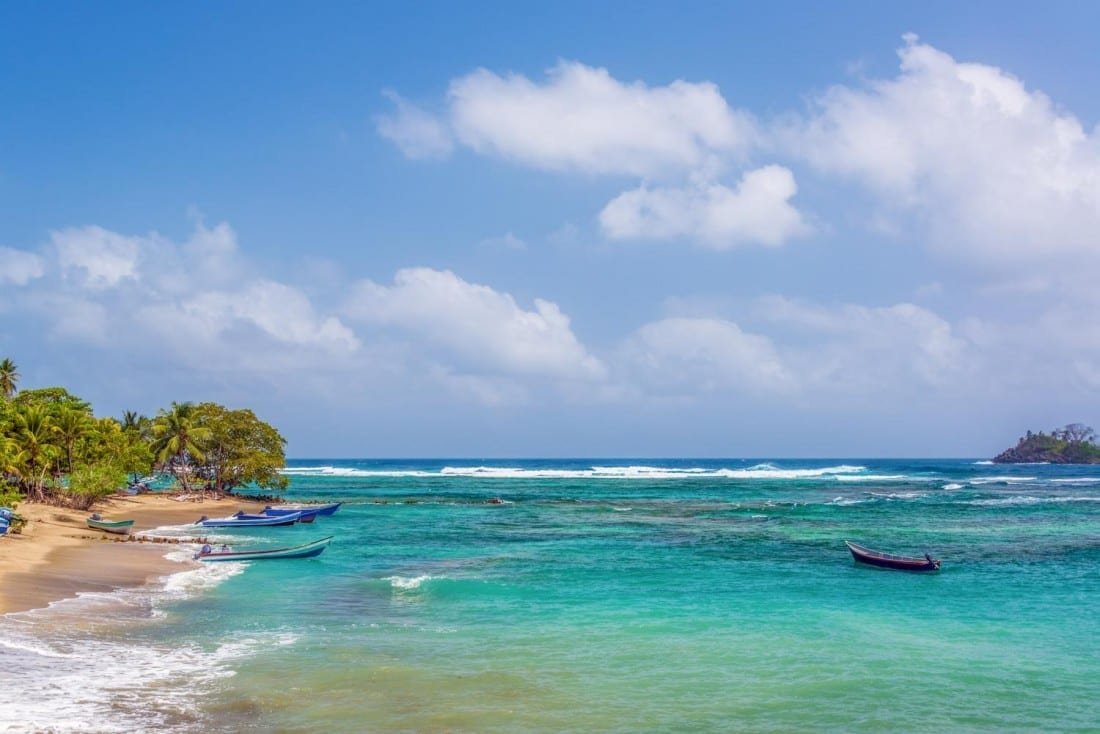The Pacific Coast of Colombia
Colombia’s Pacific Coast lies just west of the Cordillera Occidental—the westernmost branch of the Andes.
The northern coast, where the Baudó Range crumbles into rugged coves and bays, is backed by some of the planet’s most biodiverse rainforest and mangrove habitat.
To the south, countless rivers spill down to a wide coastal plain.

Colombia’s pacific coast, or ‘El Choco’ is largely uninhabited and undeveloped—most access is by air and sea.
Bahia Solano
The pacific coast’s largest settlement is Bahia Solano, sheltered in the Gulf of Cupica.
This Colombian coastal town has earned an international reputation for:
- World-Class Catch-and-Release Sport Fishing—(May to September)
- Whale Watching Tours (July to October)
Bahia Solano is also flanked by excellent beaches, surf breaks, waterfalls, and hiking trails.
Scuba Dive with Whale Sharks
The beaches at Guachalito and Punta Huina (best reached by water taxi) offer relaxation, hiking, and snorkeling.
Divers can enjoy swimming with whale sharks (September to January) and exploring the scuttled wreck of the WWII-era Sebastian de Balalcazar—now an artificial reef.
From January to March, you can encounter schools of up to 200 hammerheads and nearly 1,000 silky sharks here.

Ensenada de Utria
In the southern portion of Colombia’s pacific coast lies Parque Nacional Natural Ensenada de Utria, which preserves coral reef, mangrove estuary and tropical humid forest habitats.
While Sea turtles nest here from September to December at Playa Almejal and Estacion Septiembre, the pacific’s greatest draw is its humpback whales.
Esenada’s narrow inlet is one of the best places on earth to see these migrating giants from land.
Gorgona Island Scuba
Colombia’s southern pacific coast also offers two epic dive locations: Gorgona Island (35 miles west of the coast) and Malpelo Island (315 miles into the Pacific).
Gorgona is also the site of the largest coral bank in the Colombian Pacific—habitat for dolphins, sea lions, sharks, sea turtles, and morays.
Humpback calves are frequently observed here in August and September. The island is usually visited on four-day dive trips, launching from the town of Guapi.

Diving Malpelo Island
For advanced divers, Malpelo Island is among the most appealing destinations in the eastern Colombian Tropical Pacific.
Week-long dive trips (originating in Panama, Costa Rica, and Colombia) are often booked-up a year in advance.
El Choco Rainforests
Away from the pacific coast, El Choco’s rainforests overflow with even greater biodiversity. No other nation houses more bird species—over 1,875 and counting.
Nearly 800 of those have been spotted in El Choco, which serves as the migratory corridor between two oceans and two continents.
One of the best birdwatching locations is Katios National Natural Park, a 278-square mile protected area, and a UNESCO World Heritage Site.
Serrania del Darien and The Atrato River
Its habitats include the mountains of the Serrania del Darien and the floodplain of the Atrato River, which flows into the Caribbean.

Native species found at Katios National Park include:
- Rufous-Cheeked Hummingbirds
- Violet-capped Hummingbirds
- Choco Tinamou
- Speckled Ant-Shikes
- Baird’s Tapirs
- Manatees
- Giant Anteaters
The Colombian Pacific has fairly consistent weather year round: highs from 87° F to 92° F and overnight lows near 70° F.
This is a rainforest region, and one of the wettest places on earth. Average monthly precipitation exceeds 19 inches—less in January and February, more during the remaining months.
Getting to The Pacific coast of Colombia
Non-stop flights operated by the Satena domestic airline connect Bogota’s El Dorado airport with Bahia Solano (BSC) on Mondays, Wednesdays, Fridays, and Sundays.
Approximate flying time is 45 minutes. Rain delays are not uncommon.

“A man who dares to waste one hour of time has not discovered the value of life.”
Charles Darwin
—— COMBINE WITH
BARICHARA & SAN GIL
BOGOTA
CARTAGENA
